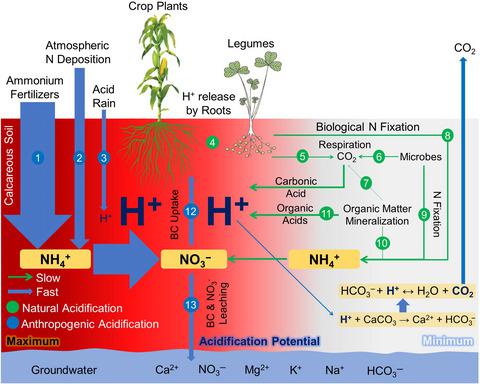当前位置:
X-MOL 学术
›
Glob. Change Biol.
›
论文详情
Our official English website, www.x-mol.net, welcomes your
feedback! (Note: you will need to create a separate account there.)
Dramatic loss of inorganic carbon by nitrogen-induced soil acidification in Chinese croplands.
Global Change Biology ( IF 10.8 ) Pub Date : 2020-04-22 , DOI: 10.1111/gcb.15101 Sajjad Raza 1 , Na Miao 1 , Peizhou Wang 1 , Xiaotang Ju 2 , Zhujun Chen 1 , Jianbin Zhou 1 , Yakov Kuzyakov 3
Global Change Biology ( IF 10.8 ) Pub Date : 2020-04-22 , DOI: 10.1111/gcb.15101 Sajjad Raza 1 , Na Miao 1 , Peizhou Wang 1 , Xiaotang Ju 2 , Zhujun Chen 1 , Jianbin Zhou 1 , Yakov Kuzyakov 3
Affiliation

|
Intensive crop production systems worldwide, particularly in China, rely heavily on nitrogen (N) fertilization, but left more than 50% of fertilizer N in the environment. Nitrogen (over) fertilization and atmospheric N deposition induce soil acidification, which is neutralized by soil inorganic carbon (SIC; carbonates), and carbon dioxide (CO2 ) is released to the atmosphere. For the first time, the loss of SIC stocks in response to N-induced soil acidification was estimated for Chinese croplands from 1980 to 2020 and forecasts were made up to 2100. The SIC stocks in croplands in 1980 were 2.16 Pg C (16.3 Mg C/ha) in the upper 40 cm, 7% (0.15 Pg C; 1.1 Mg C/ha) of which were lost from 1980 to 2020. During these 40 years, 7 million ha of cropland has become carbonate free. Another 37% of the SIC stocks may be lost up to 2100 in China, leaving 30 million ha of cropland (37.8%) without carbonates if N fertilization follows the business-as-usual (BAU) scenario. Compared to the BAU scenario, the reduction in N input by 15%-30% after 2020 (scenarios S1 and S2) will decrease carbonate dissolution by 18%-41%. If N input remains constant as noted in 2020 (S3) or decreases by 1% annually (S4), a reduction of up to 52%-67% in carbonate dissolution is expected compared to the BAU scenario. The presence of CaCO3 in the soil is important for various processes including acidity buffering, aggregate formation and stabilization, organic matter stabilization, microbial and enzyme activities, nutrient cycling and availability, and water permeability and plant productivity. Therefore, optimizing N fertilization and improving N-use efficiency are important for decreasing SIC losses from acidification. N application should be strictly calculated based on crop demand, and any overfertilization should be avoided to prevent environmental problems and soil fertility decline associated with CaCO3 losses.
更新日期:2020-04-01






























 京公网安备 11010802027423号
京公网安备 11010802027423号